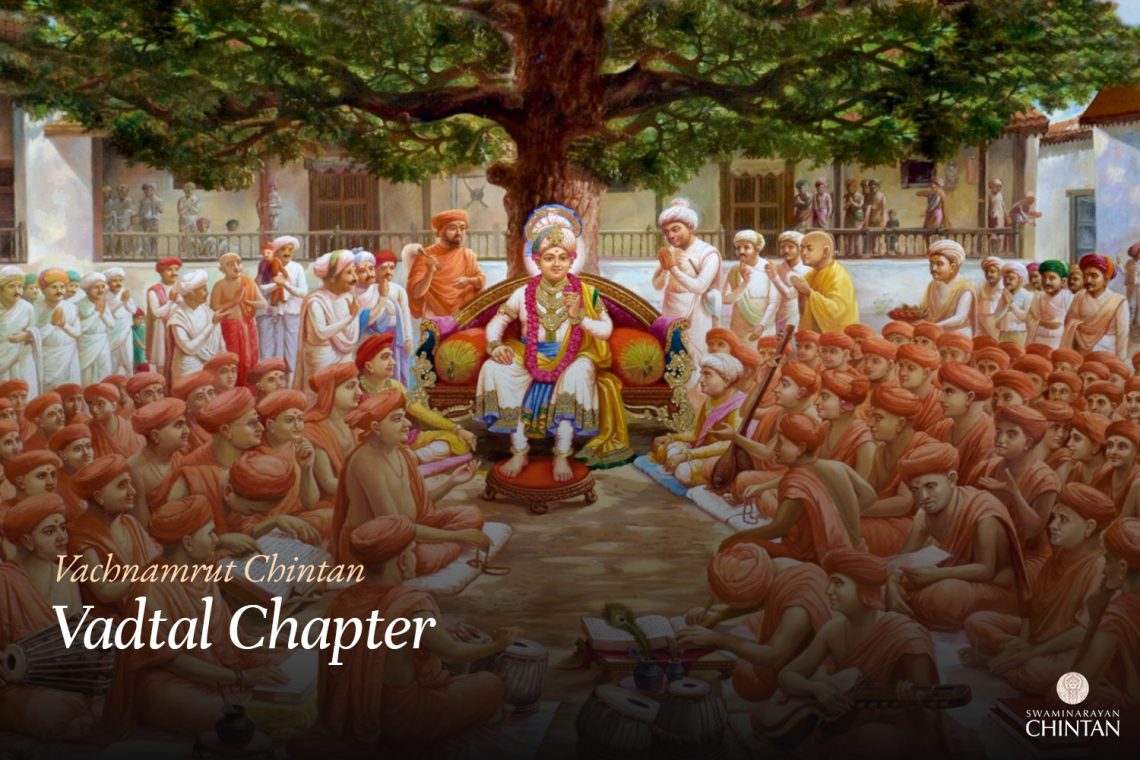Central Insights:
- The divinity of Bhagwan’s murti.
Key Points:
- Bhagwan’s murti inherently contains divine miracles.
- Bhagwan is eka-deshi yet also sarva-deshi.
Explanation:
In this Vachanamrut, Bhagubhai Patidar from Bhadaran asked Maharaj, “How does a person go into samadhi (trance)?” The phrasing of “this” in his question suggests that someone must have recently gone into samadhi after seeing Maharaj.
Maharaj replied, “For the welfare of souls, Bhagwan takes avatar in Bharatkhanda. Although the murti of Bhagwan appears human, it possesses extraordinary divinity. Just as many stones exist on earth, yet a lodestone differs due to its miraculous magnetic power that attracts iron nails, similarly, when a soul views Bhagwan’s murti with faith, his senses are drawn toward Bhagwan, causing an immediate samadhi.
Maharaj further elaborated that this miraculous power to draw the senses inward is present in Bhagwan’s murti, regardless of the specific form Bhagwan has assumed, whether it is in a human form or another. Bhagwan stated that even if He assumes a murti that is not exceptionally beautiful, the divine attraction remains. For example, when Vyasa incarnated, his body was that of a rishi with dark skin and rough features, yet his murti held the same divine power. Whenever Bhagwan manifests, even if in another form, the attraction and divinity are inherently different from other forms. Thus, if anyone gazes upon His murti with sincere devotion, their senses and inner faculties are immediately drawn toward Him.
During the time of Shreeji Maharaj, thousands would enter into samadhi according to this truth. Moreover, when Bhagwan descends on earth and wills, through His supreme compassion, even unworthy beings, animals, and birds may go into samadhi upon seeing Him. Maharaj’s murti is the ultimate example of this divine attraction. Bhagwan’s will draws the senses and inner faculties to Him, and His murti holds them captivated. This is why the shastras describe Bhagwan as इत्थंंभूूतगुुणो हरि itthambhut-guno Hari — His murti forcibly attracts all to itself. Therefore, it is Bhagwan’s murti that is the cause of samadhi, while the soul’s earnest longing for the divine can serve as an underlying factor for His compassionate will to be drawn towards it. When a soul’s sincere striving aligns with this divine longing, it gains support through sadhan (spiritual practices), which is inspired by sharanagati (complete surrender). This sharanagati is strengthened by the association of true sants, auspicious merit, and a unique occasion that provides the opportunity for this fortune, all of which a seeker should understand.
Later, Muktanand Swami asked Maharaj, “Everyone says that Brahm is pervasive. How, then, can that which is pervasive also possess form? If it has form, how can it pervade all?” Here, Brahm implies Paramatma (Supreme Soul), so how can You, as Paramatma, who is constantly with form, be pervasive? If we say Brahm is pervasive, it must be formless. Enlightened devotees and the Upanishads consider You to be pervasive — how should this be understood?”
Maharaj responded that Brahm is ekadeshi but not sarvadeshi. This Brahm is Shree Krishna Bhagwan. Though ekadeshi, Bhagwan is also sarvadeshi. In the language of the shastras, ekadeshi means residing in one place, or having form, as He primarily remains in His dham (divine abode). As such, He is ekadeshi. Sarvadeshi means existing everywhere in a formless manner, but Maharaj is not formless.
Maharaj stated that Bhagwan is ekadeshi, yet sarvadeshi. In other words, Bhagwan eternally possesses a form and eternally resides in His dham, while also pervading all. He resides everywhere not by becoming formless but through His yog powers. Through His divinity, He can manifest in the smallest of particles in countless brahmands and remain present wherever He wishes. Thus, He is both ekadeshi and sarvadeshi, which is Bhagwan’s unique glory. Maharaj further explained that, if even a siddha (one who possesses superhuman powers) can see or hear over great distances, Bhagwan — the Yogeshwar of all yogeshwars and the “ocean of yog skills” — can certainly do so with ease. Therefore, Bhagwan is eternally with form and, though with form, pervades the infinite brahmands. There is no need for Him to become formless to pervade all, as He is fully capable of doing so from His dham where He sits on His divine throne.
Glossary
| Murti – Divine form of God Refers to Bhagwan’s physical or imagined divine form, which provides joy and spiritual connection during contemplation. |
| Samadhi – Deep meditative state A state of deep, focused meditation, where the body remains unconscious and the mind is absorbed in God and divine experience |
| Paramatma – Supreme God God, the all-pervading and ultimate reality. |
| Ekadeshi – Residing in one place, having form Refers to Bhagwan’s nature of residing primarily in His divine abode (dham), possessing form, and being locally present in a specific place, yet still pervading all creation. |
| Sarvadeshi – Existing everywhere in formlessness The ability of Bhagwan to pervade all of creation, not by becoming formless, but through His divine yog powers, maintaining His form while being omnipresent. |
| Brahm – Supreme Reality, God The ultimate truth in Vedant, often misinterpreted by dry Vedantists. |
| Dham – Divine abode of God |
| Yogeshwar – Master of all yogic powers The supreme being who is the controller and possessor of all yogic powers, capable of manifesting in countless forms and pervading all dimensions, as explained by Bhagwan’s divine abilities. |
| Siddha – Souls who have attained supernatural abilities but remain in the cycle of creation. |
| Chidakash – Pure consciousness space The undiluted, transcendental consciousness that pervades the universe, from which divine happiness and recognition of Bhagwan arise. |
| Pruthvi-Tattva – Earth element |

